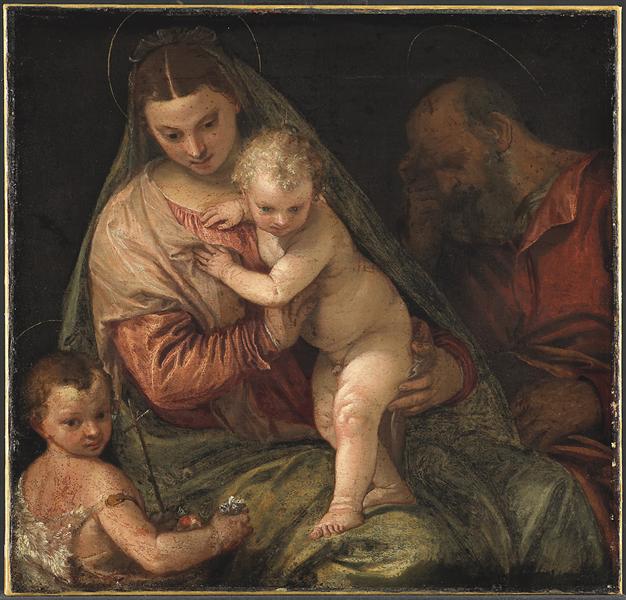Description
The painting "The Holy Family with the Infant John the Baptist," created in 1575 by Paolo Veronese, emerges as a splendid example of the late Venetian style, steeped in the rich tradition of the Renaissance. Capturing a serene and familial scene, this painting reflects not only Veronese's technical mastery, but also his ability to imbue a sense of authority and solemnity in his figures through composition and use of color.
When looking at the work, one notices a careful arrangement of the three central characters: the Virgin Mary, the Infant Jesus and the infant Saint John the Baptist. Mary, dressed in a deep blue cloak that symbolizes purity and virtue, tenderly holds the Infant Jesus, who is presented in a moment of fragility and spontaneity. This child, with an innocent and radiant gaze, stands out against the darker, more nuanced background, creating a strong contrast that draws the viewer's attention to him. Veronese achieves a balance between the emotion of motherhood and divinity, a recurring theme in his work.
The Infant Saint John the Baptist, on the right side of the composition, is also depicted with an air of comfortable contentment, holding a small staff, a symbol of his future role as a precursor of Christ. This small detail takes on significant relevance, as it links the relationship between the infants to a sense of destiny and purpose, a common thread that Veronese skillfully weaves into his visual narratives.
The palette used in this work is rich and vibrant, characteristic of Veronese's style. The warm, golden colours that dominate the scene evoke a heavenly light, giving the characters a halo that suggests divinity. The transitions between tones are smooth, and details such as the delicate folds of the clothes and the texture of the faces are treated with meticulous attention. Light plays a fundamental role, illuminating the children's faces and creating a play of shadows that adds depth and volume to the scene, a technique that Veronese mastered with mastery.
In terms of the composition, Veronese employs a triangular format that not only provides stability, but also creates a sense of unity between the figures. This guided arrangement is aligned with Renaissance ideals, where harmonious proportions and balance are key. However, Veronese also innovates by including a natural background that can be perceived above, which adds an almost narrative dimension, suggesting that the Holy Family does not stand alone, but immersed in a world that still connects with everyday life.
While the work is a testament to Veronese’s virtuosity, it also reflects the cultural context of its time. During the Renaissance, artists sought not only to replicate aesthetic beauty but also to communicate deeper meanings, which translates into this composition that engages with both subtle and monumental elements of spirituality and family.
Although The Holy Family with the Infant John the Baptist is not as well known as some of his more iconic masterpieces, it stands as a revealing example of the style of Paolo Veronese, whose ability to blend the sacred with the everyday remains a source of admiration in art history. His focus on color, light, and composition, along with his exceptional ability to portray emotions, guarantees a prominent place for this work within the rich tapestry of the Venetian Renaissance.
KUADROS ©, a famous painting on your wall.
Hand-made oil painting reproductions, with the quality of professional artists and the distinctive seal of KUADROS ©.
Painting reproduction service with satisfaction guarantee. If you are not completely satisfied with the replica of your painting, we will refund 100% of your money.

